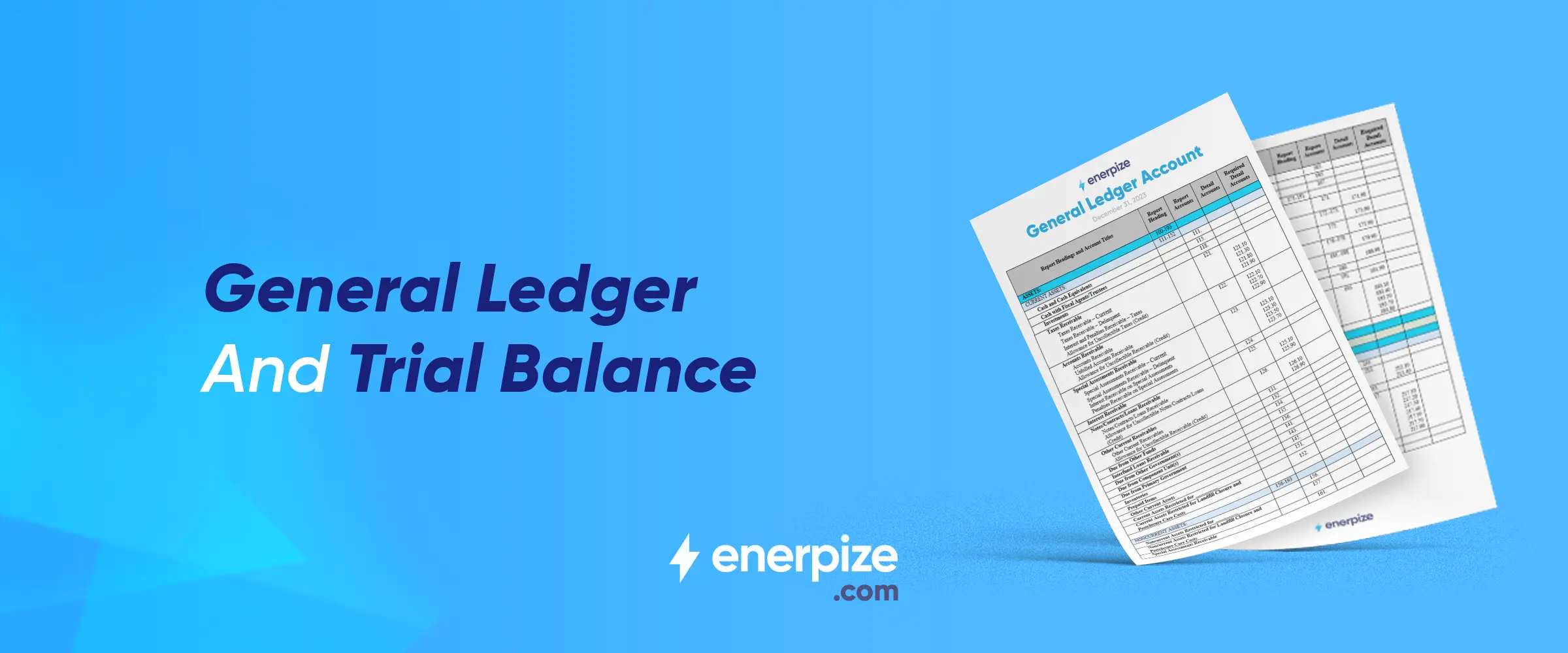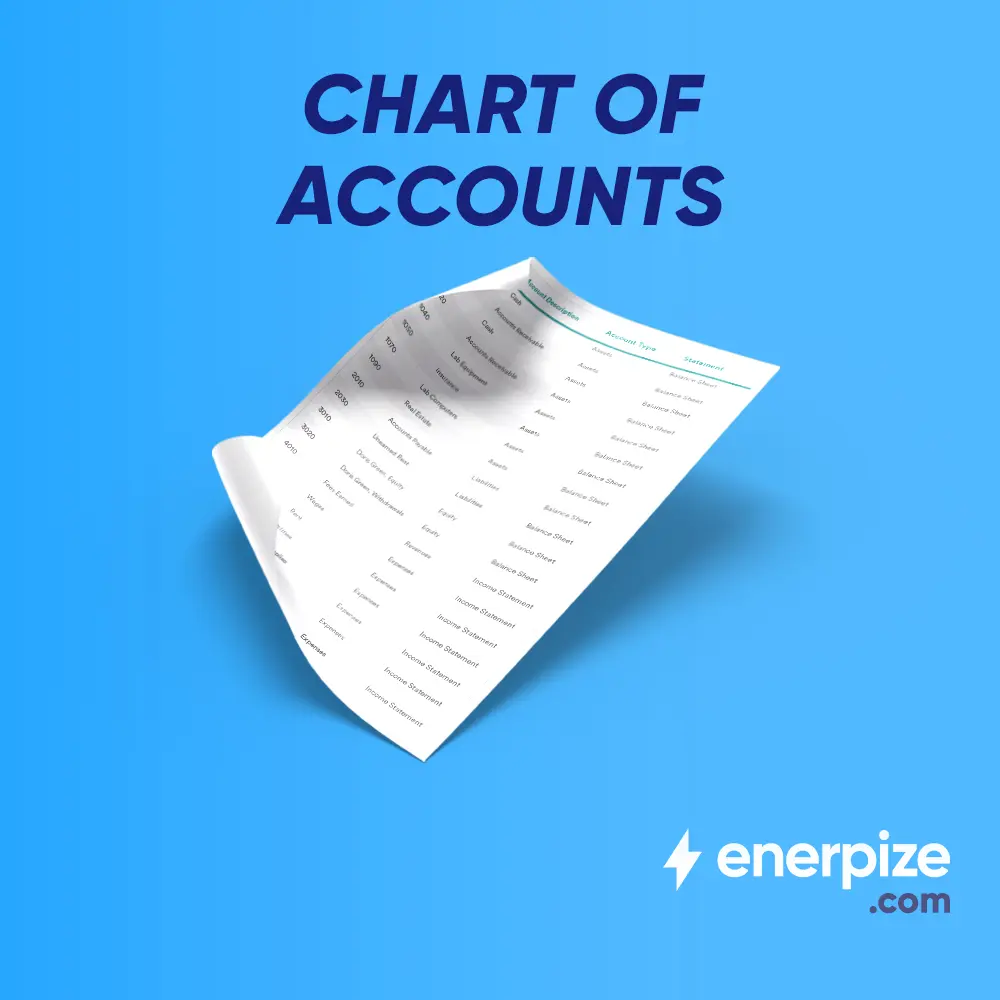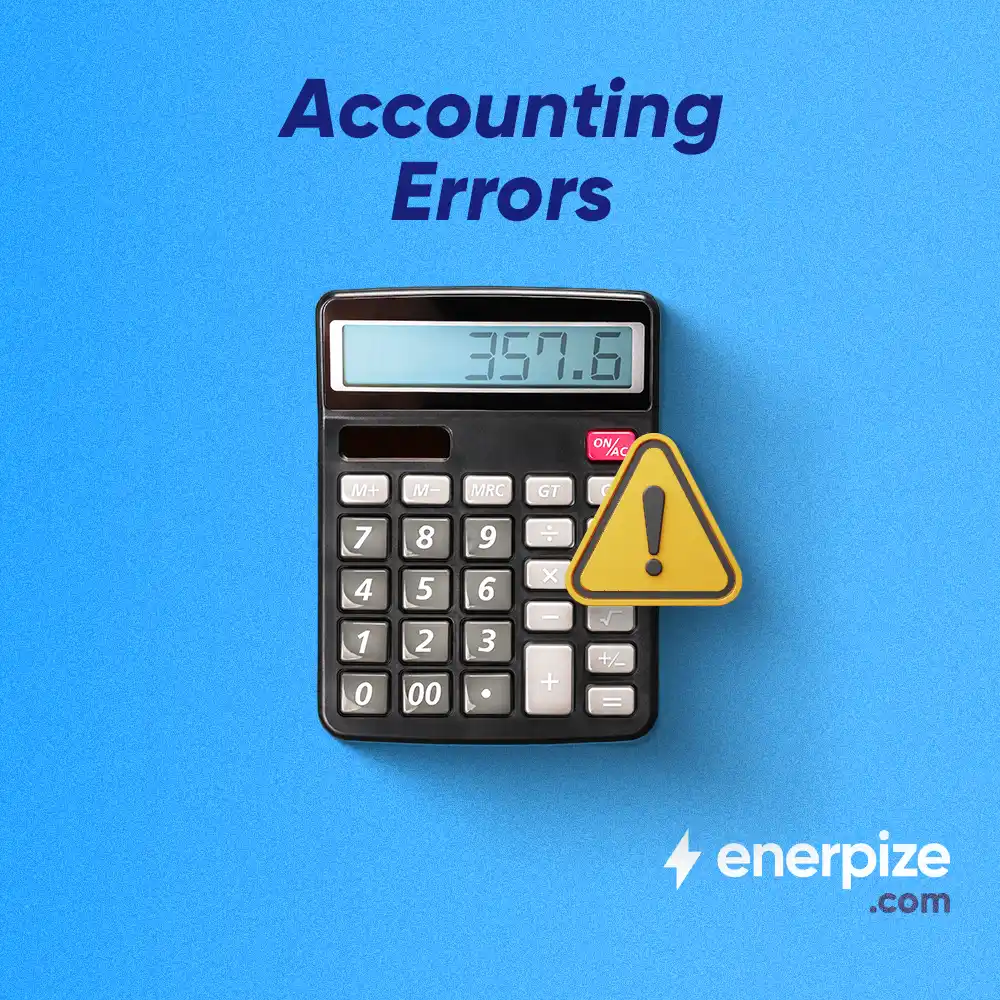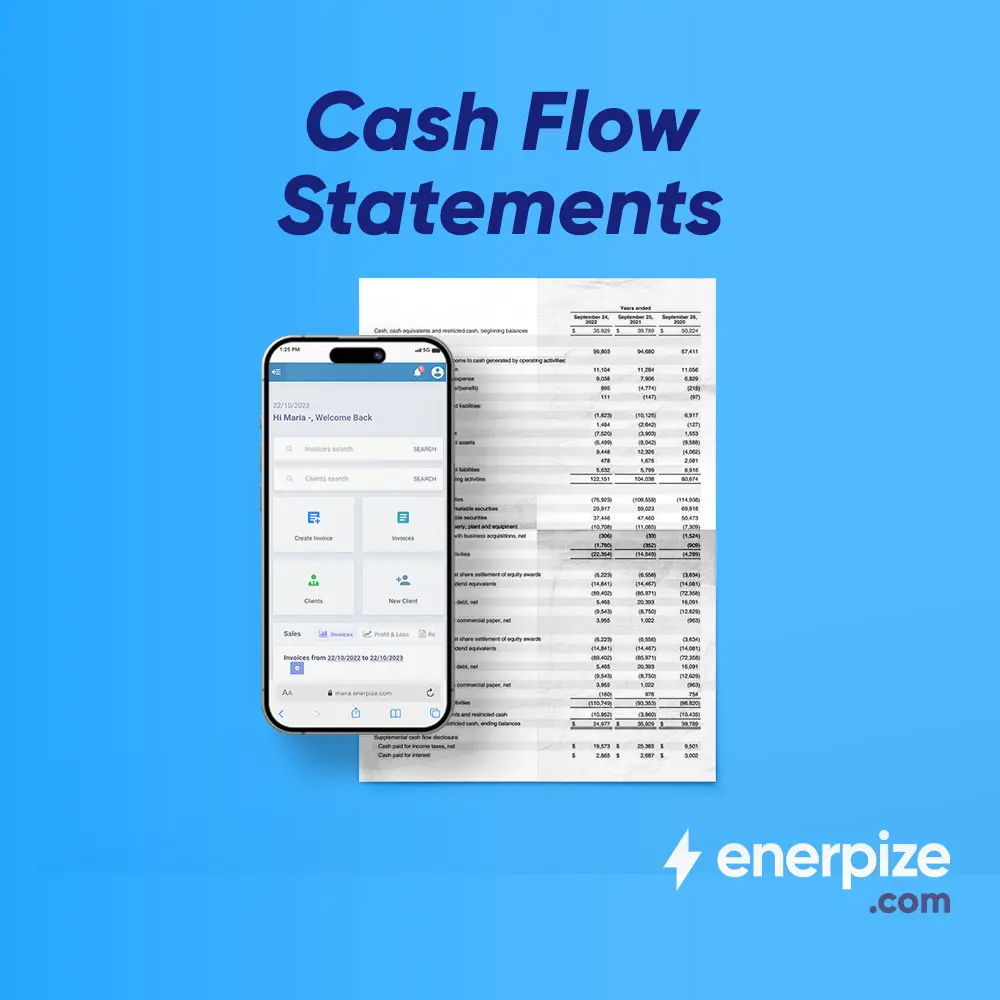Author : Haya Assem
Reviewed By : Enerpize Team
Key Differences between General Ledger and Trial Balance

Table of contents:
- What is a general ledger?
- How a general ledger works
- What is a trial balance?
- How does trial balance work?
- Difference between the general ledger and trial balance
- How to prepare a trial balance?
- Reasons why a trial balance might have inaccuracies
- What is the trial balance formula?
- Examples of general ledger and trial balance
- How does Enerpize help in creating the general ledger and trial balance?
- Final thoughts
Financial management can be a complex and challenging task. It is based on keeping accounting records and reports that record the financial transactions that have taken place within a given period.
The general ledger is one of these documents. It shows every account associated with the company, as well as its debits and credits. In this instance, there must be a critical step to determine the balance of each account inside the entity, and the trial balance performs this step.
Therefore, the general ledger and trial balance are important guides, leading you through the maze of financial complications while verifying the accuracy of your financial statements and the equilibrium of your accounting records.
This will result in more exact control over financial activities, which will help in developing strategic decisions based on reliable and timely information.
Key Takeaways
- The general ledger records all financial transactions organized into accounts like assets, liabilities, and revenues. It’s a detailed, ongoing record that forms the foundation of a company’s financial reporting and supports accurate statement preparation.
- The trial balance is a periodic summary that lists the ending balances of general ledger accounts, sorted into debit and credit columns. Its purpose is to confirm that debits and credits match, ensuring the accuracy of the accounting records.
- While the general ledger offers detailed entries for every transaction, the trial balance only shows totals. It acts as a checkpoint that helps detect any errors before financial statements are finalized.
- The general ledger uses double-entry accounting, meaning each transaction affects at least two accounts with equal debits and credits. This ensures the accounting equation, Assets = Liabilities + Equity, remains balanced.
- Trial balance errors can happen due to misclassified accounts, missing or duplicated entries, or incorrect transfers. Identifying and fixing these errors is essential to maintain trustworthy financial records.
What is a general ledger?
The general ledger (GL) is a key component of a company's accounting system. It is a record of all the transactions of the company, grouped in the form of accounts. The general ledger records every financial activity, including sales, expenses, assets, liabilities, and equity changes.
The general ledger classifies these transactions into several accounts, each reflecting a different financial aspect (for example, accounts receivable, accounts payable, cash, income, and expenses).
Its importance lies in:
- Ensuring accurate financial reporting by serving as the basis for creating financial statements.
- Providing a detailed financial history, aiding in decision-making.
- Simplifying tax compliance by providing a clear record of financial transactions.
- Contributing to the preparation of a trial balance and financial statements for any entity.
Read Also: General Ledger VS Subledger: A Comprehensive Guide
How a general ledger works
The main purpose of a general ledger is to save and organize all financial transactions in order to create a company’s financial statements. All financial data such as (sales, purchases, expenses, and investments) are initially recorded in a sub-ledger according to the company’s chart of accounts.
The financial data are then summarized and transferred or posted from the sub-ledger to the general ledger after debiting and crediting all accounts to ensure that they balance. Posting to the general ledger is usually done at the end of a reporting period (e.g., monthly, or annually).
The general ledger follows the double-entry accounting principles. Indicates that each financial transaction has an impact on two sub-ledger accounts, and each entry has at least one debit and one credit transaction.
This means that for every debit (an entry on the left side), an equal credit (an entry on the right side) must exist. Debits and credits should always balance, ensuring that the accounting equation: Assets = Liabilities + Equity is maintained.
After all entries are made and balanced, a trial balance is created to confirm that the total debits equal the total credits. If they do not balance, it shows that there are errors that must be fixed.
Read Also: What are Journal Entries in Accounting: Examples, Format, and Types
What is a trial balance?
The trial balance is one of the most important processes in the accounting cycle since it consolidates debit and credit accounts and determines their balances. It is generated at the end of each financial period but preparing it monthly or quarterly makes it easier to identify issues and examine financial activities, resulting in more accuracy in the accounts.
The most important part of the trial balance is that the debit side should equal the credit side of the recorded accounts.
The entire process is done through the accounts in the general ledger. Therefore, to avoid errors in the trial balance, it is critical to verify the accuracy of the general ledger accounts.
How does trial balance work?
To prepare a trial balance, you need to prepare a list of all general ledger accounts. This list should include the balance of each account. Transfer each account's ending balance to the trial balance.
Accounts with debit balances are listed on the debit side, and accounts with credit balances are listed on the credit side. Initially, the total debits and total credits should be equal.
If the trial balance does not balance (i.e., if total debits do not equal total credits), the next step is to identify and correct the inaccuracies. Common errors may include transposed numbers, missing entries, or misclassified transactions.
Read Also: What is POS Transaction: Types, Benefits, & How They Work?
Difference between the general ledger and trial balance
The general ledger and trial balance are essential components of the accounting process, each with its distinct purpose and importance in assuring the accuracy and transparency of a company's financial records. These tools work together, yet they serve different purposes that contribute to overall financial management.
Points of comparison | General Ledger | Trial Balance |
Purpose | The general ledger is a comprehensive and up-to-date record of all financial transactions in a company. It gives a thorough history of financial transactions, categorizing them into separate accounts. Its primary purpose is to maintain a complete and organized record of all financial data for the company. | The trial balance is a report that is created at a specified time. It checks the general ledger's accuracy by ensuring that total debits match total credits. Its principal function is to detect inaccuracies in accounting and financial records. |
Content | The general ledger contains all the detailed information about transactions, including dates, descriptions, and specific amounts, categorized into various accounts such as assets, liabilities, equity, revenues, and expenses. | The trial balance, in contrast, summarizes the total debit and credit balances of each account at a specific moment. It doesn't provide the specific transaction details found in the general ledger. |
Frequency | The general ledger is constantly updated with each financial transaction, making it an ongoing record that represents the company's real-time financial activities. | The trial balance is often made after an accounting period, such as a month, quarter, or year, to evaluate the general ledger's accuracy before generating financial statements. |
Use | The general ledger is the primary source of information for the accounting department. It maintains financial records, makes adjustments, tracks historical financial performance, and generates financial statements. | The trial balance is used as a tool to ensure the accuracy of the general ledger and serves as a basis for preparing financial statements. |
How to prepare a trial balance?
Preparing a trial balance involves several steps and requires access to a company's general ledger, which contains all the account balances. Subsequently, to create an exact trial balance, all general ledger account balances must be calculated accurately.
Read Also: How to Track POS Transactions: The Complete Guide
Balance all general ledger accounts
Start by listing all of the general ledger accounts. Assets, liabilities, equity, revenue, and expenses are the most common categories for these accounts. Each account has its own balance that should be calculated separately first.
Record debit or credit balances in the trial balance
Following the calculation of the closing balances of each account for the accounting period. The calculated balance should be transferred to the trial balance with their debit and credit balances.
Set up the trial balance format
The next step is to prepare the trial balance worksheet. Create a table or spreadsheet with three separate columns labeled "The names of each ledger account", "Debit" and "Credit" and the balance of each account.
Calculate the total of the debit and credit columns
After recording all of the credit and debit balances of the various general ledger accounts in the trial balance columns. Determine the total of each column.
Close the trial balance
The final step is to ensure that the debit column total equals the credit column total. As mentioned before, a trial balance is created to ensure the accuracy of the debit and credit balances of various general ledger accounts. If the balances do not match, this indicates that there were some errors made while recording transactions in the general ledger or trial balance.
Download Now: Fee Trial Balance Template
Reasons why a trial balance might have inaccuracies
Account misclassification
Assigning a transaction to the incorrect account might result in an inaccurate balance and an unbalanced trial balance. As an example, suppose you want to post a revenue transaction to an expense account.
Missing entries
An imbalance can occur when a transaction is not recorded in the general ledger. If a transaction gets missed or overlooked, it will not be reflected in the trial balance.
Duplicate entries
Recording a transaction twice in the general ledger by mistake might result in an imbalance when creating the trial balance.
Ledger-related errors
These kinds of errors include posting an inaccurate amount in the ledger, making an entry in the wrong column, or performing a mistake while transferring ledger balances to trial balance columns.
Error in a previous trial balancing
It happens when an error is made while inputting the previous accounting period's closing balance into the current one.
What is the trial balance formula?
The trial balance formula is a simple equation that represents the basic accounting principle of double-entry bookkeeping. The formula is expressed as follows:
Total Debits=Total Credits
"Total Debits" represents the sum of all debit balances across all accounts.
"Total Credits" represents the sum of all credit balances across all accounts.
The trial balance formula guarantees that the accounting equation Assets = Liabilities + Equity is accurately applied.
Assets = Liabilities + Equity is maintained, and it ensures that the entire amount debited must equal the total amount credited for each transaction. This formula is an important tool for validating the quality of a company's accounting records and functions as a checkpoint before financial statements are prepared.
If the trial balance is in balance, it shows that the company's accounting system is being kept up to date; if it is not balanced, it indicates that potential inaccuracies in the accounting records need to be investigated and corrected.
Examples of general ledger and trial balance
As stated in this article, the trial balance is based on the general ledger's numbers and accuracy, hence, to create a trial balance, start with the general ledger, as shown in the following example:
General ledger example
Cash (Account Number: 101)
| Date | Description | Debit | Credit | Balance |
| 01/09/2024 | Capital Investment | 10,000 | 10,000 | |
| 03/09/2024 | Office Supplies | 200 | —- | 9,800 |
| 05/09/2024 | Rent Expense | 1,000 | 8,800 | |
| 10/09/2024 | Service Revenue | 2,500 | 11,300 | |
| 12/09/2024 | Utilities Expense | 300 | – | 11,000 |
Office Supplies (Account Number: 201)
| Date | Description | Debit | Credit | Balance |
| 03/09/2024 | Cash | 200 | – | 200 |
Rent Expense (Account Number: 301)
| Date | Description | Debit | Credit | Balance |
| 05/09/2024 | Cash | 1,000 | – | 1,000 |
Utility Expense (Account Number: 302)
| Date | Description | Debit | Credit | Balance |
| 12/09/2024 | Cash | 300 | – | 300 |
Capital Investment (Account Number: 401)
| Date | Description | Debit | Credit | Balance |
| 01/09/2024 | Cash | – | 10,000 | 10,000 |
Service Revenue (Account Number: 501)
| Date | Description | Debit | Credit | Balance |
| 10/09/2024 | Cash | – | 2,500 | 2,500 |
Trial balance example
The totals for each account from the general ledger entries are transferred to the trial balance in this example. The total debits match the total credits, resulting in balanced accounting records. Before finalizing financial statements, this trial balance acts as a preliminary check.
Cash
| Account Name | Debit | Credit |
| Cash | 11,000 | – |
Office Supplies
| Account Name | Debit | Credit |
| Office Supplies | 200 | – |
Rent Expense
| Account Name | Debit | Credit |
| Rent Expense | 1,000 | – |
Read more about lease accounting journal entries.
Utilities Expense
| Account Name | Debit | Credit |
| Utilities Expense | 300 | – |
Capital Investment
| Account Name | Debit | Credit |
| Capital Investment | – | 10,000 |
Service Revenue
| Account Name | Debit | Credit |
| Service Revenue | – | 2,500 |
How does Enerpize help in creating the general ledger and trial balance?
Through the Enerpize online accounting software based on the data entered as manual entries or automatic entries resulting from all your transactions, Enerpize transforms all these entries into a report that you can instantly extract. This report shows the total assets, liabilities, and all your accounting items arranged based on the debit and credit duality. You have control through search settings to review the account you want to see in the general ledger. In the end, you can either transition to view the details of the entry you want by clicking on it or download the ledger report in the format you specify.

Final thoughts
In summary, the general ledger and trial balance are essential accounting tools that work together to keep accurate financial records, facilitate decision-making, assure regulatory compliance, and lay the foundation for effective financial management. Their importance stems from their capacity to provide transparency, precision, and a systematic approach to financial data management within an organization.
General Ledger and Trial Balance is easy with Enerpize.
Try our accounting module to create your documents easily








